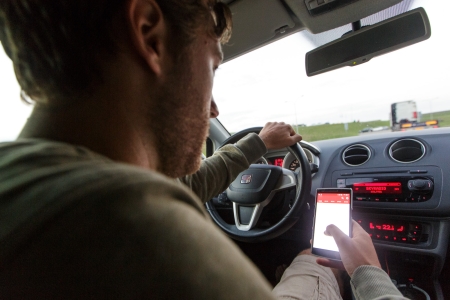There are three kinds of countermeasures targeting driver distraction: people-focused, technical and infrastructural countermeasures (also see [62]).
People-focused countermeasures
People-focused countermeasures, such as education, and enforcement of the legal ban, may motivate drivers to abstain from distracting activities while participating in traffic. In the Netherlands, there have been a lot of public information campaigns to alert people to the dangers of distraction by devices (‘Don’t get distracted’, ‘OFFline ON the road’ and more recently the MONO campaign). The campaigns proved to be successful in that a large majority (97%) of Dutch drivers deem phone use while driving to be dangerous [4]. Nevertheless, 65.6% of drivers admitted having sometimes used a mobile phone while driving.
Handheld use of mobile electronic devices (among which phones, navigation systems, tablets and music players) intended for communication and information processing while driving is illegal (see the question What do regulations about phone use in traffic amount to?). It is hard to determine the effectiveness of a ban on mobile phone use. The available, mostly American, studies of the effectiveness of this ban to decrease the number of road deaths do not present a clear picture, as shown by a recent review article by [63]. Some studies find that the number of road deaths decreased after the introduction of a ban specifically targeting handheld phoning or texting. Other studies, however, find no such correlation. After only a short period, a combined ban (both on handheld phoning and texting) appeared to be effective in decreasing the number of road deaths. Proof for the effectiveness of the ban was weak however, since the impact of other factors (for instance road safety measures whose introduction was concurrent to the ban) was not taken into account.
When introducing a legal ban, it is important to increase the (subjective) probability of detection and to impose substantial fines for engaging in distracting activities. In the Netherlands, in 2020, the fine for holding a mobile phone while driving was 240 euros. The probability of detection is low however. The ban is mostly enforced by means of police stops – but only after police have noticed someone holding a phone while driving. Technologies to increase the probability of detection are being developed. Since October 2019, Dutch police have used smart cameras that look through the windscreens of passing cars [64]. The camera recognises whether a driver is holding a phone and what the car’s registration number is. Afterwards a police officer checks whether the camera observed the offence correctly. If so, the holder of the registration certificate will be sent a fine, which is similar to procedures for speeding fines.
Technical countermeasures
Technical countermeasures make use of technology to prevent distraction in traffic. On smartphones, apps may be installed (e.g. the ‘Auto Reply App’, ‘Drive Safely Keep Focused’, and ‘Automodus’) which discourage or disenable the use of some telephone functions while driving. Research shows that these apps diminish phone use by novice drivers [65] [66] [67] and by adults [68]. while driving. Such apps are, however, not highly appreciated by drivers and may easily be circumvented.
Smartphones can also be made less (visually) distracting by replacing manual operation with voice-controlled operation. This is, however, no solution to prevent cognitive distraction (being preoccupied with something else than traffic). Moreover, distracting tasks take longer to complete by voice control (see the questiong Is handsfree telefoongebruik minder gevaarlijk dan handheld?).
There are also new technical in-car systems to prevent (the consequences of) distraction. Special sensors may, for example, warn distracted drivers in case of danger. The downside is that this may unintentionally encourage drivers to engage in distracting activities.
Infrastructural countermeasures
Infrastructural countermeasures may ensure that the road environment is designed so that objects leading to driver distraction, for example advertisements, are absent (see the question How distracting is roadside advertising?). Certain infrastructural countermeasures, such as profiled road marking and obstacle-free road shoulders may mitigate the consequences of distraction.
